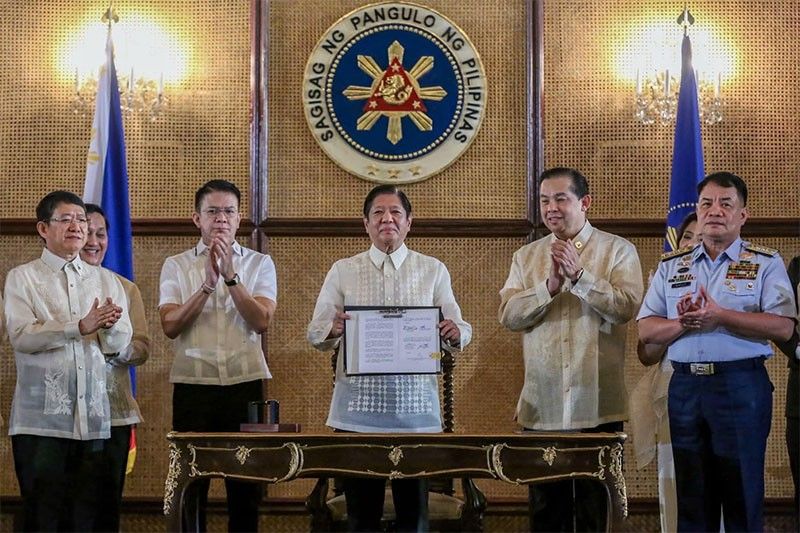New Philippines maritime laws get US backing, anger China

MANILA, Philippines — The United States has lauded the Philippines’ enactment of the Maritime Zones Act that seeks to further buttress the country’s sovereign rights over its waters, particularly the West Philippine Sea, in accordance with international law.
In a statement, the US State Department, through spokesman Matthew Miller, said the new law, signed on Friday by President Marcos, aligns Philippine domestic laws with the 1982 United Nations Convention on the Law of the Sea (UNCLOS) and the 2016 Arbitral Tribunal ruling.
“This law defines the Philippines’ internal waters, archipelagic waters, territorial sea, contiguous zone, exclusive economic zone and continental shelf in line with the Convention,” Miller said.
“The United States values Philippine leadership in upholding international law, particularly in the South China Sea, and calls on all states to comport their maritime claims to the international law of the sea as reflected in the Convention,” he said.
He clarified that other nations, including fellow members of the Association of Southeast Asian Nations (ASEAN), had enacted similar legislation over the years.
“The passage of the Maritime Zones Act by the Philippines is a routine matter and further clarifies Philippine maritime law,” he pointed out.
National Security Adviser Eduardo Año, meanwhile, thanked Marcos for signing the Philippine Maritime Zones Act and the Philippine Archipelagic Sea Lanes Act and the Senate and the House of Representatives for passing the landmark legislations.
“This marks a pivotal moment in fortifying our maritime sovereignty and securing our national interests, aligned with international law and in accordance with the Philippines’ rights and obligations under the UNCLOS,” he said.
“With the Philippine Maritime Zones Act, we reaffirm our sovereignty over our internal waters, territorial sea, archipelagic waters, as well as our sovereign rights and jurisdiction over the exclusive economic zone (EEZ) and continental shelf,” he added.
Año said the new laws provide a clear and robust legal framework for protecting and managing the country’s maritime resources and entitlements, ensuring their sustainable use for the benefit of the Filipino people.
“In doing so, it further strengthens our legal standing in line with the 2016 Arbitral Ruling and international norms. Equally important is the Philippine Archipelagic Sea Lanes Act, which enables us to regulate the passage of foreign vessels and aircraft within our archipelagic waters. This legislation ensures that our maritime domain remains secure and that foreign activities within our waters are effectively regulated and conducted in a manner that respects Philippine sovereignty and national security,” he explained.
“It establishes vital safeguards to protect both our maritime resources and the environment, reinforcing our responsibility to uphold the sanctity of our waters and airspace,” he said.
Año said the enactment of both laws is a significant step toward securing the Philippines’ rights over its vast maritime territories, most especially in the WPS.
The “legal instruments solidify our territory and enhances our ability to protect our country against any infringement. As an archipelagic and maritime nation, our seas are crucial to our economic prosperity and national security,” he stressed.
“These laws empower us to govern our maritime zones effectively, while promoting lawful and peaceful maritime activities,” Año added. “We are committed to working closely with all relevant stakeholders to ensure the full implementation and enforcement of these vital pieces of legislation.”
Beijing protest
The enactment of the two laws, however, has angered Beijing, which summoned the Philippine ambassador to relay its “strong protest.”
Chinese Foreign Ministry spokesperson Mao Ning said the signing of the measures “seriously infringes on China’s territorial sovereignty and maritime rights and interests in the South China Sea.”
“China strongly condemns and firmly opposes it,” she said, referring to President Marcos signing the measures. She said Malacañang’s move was an attempt by Manila to “solidify the illegal ruling of the South China Sea arbitration case through domestic legislation.”
Confrontations between Chinese and Philippine coast guard and naval forces in the West Philippine Sea have spiked alarmingly since last year, and sparked fears that the US – a longtime treaty ally – may get drawn into a major conflict.
Marcos signed the measures in a nationally televised ceremony attended by top military and national security officials. The two measures further cement the Philippines’ rejection of China’s claims to virtually the entire sea passage, and stipulate jail terms and stiff fines for violators.
“These signal our resolve to protect our maritime resources, preserve our rich biodiversity and ensure that our waters remain a source of life and livelihood for all Filipinos,” Marcos said after signing Republic Act 12064 or the Philippine Maritime Zones Act and RA 12065 or the Archipelagic Sea Lanes Act.
In a new national map it released last year, the Chinese government demarcated its claim to virtually the entire South China Sea with vague dash lines that drew protests and rejections from the Philippines and rival coastal states and governments including Malaysia, Vietnam, Taiwan and Indonesia.
The Maritime Zones Act demarcates key parts of the Philippine archipelago’s territory and outlying waters where it has full sovereignty and sovereign rights under international law and the 1982 UNCLOS, Philippine officials said.
Those zones include the country’s exclusive economic zone, a 200-nautical-mile (370-kilometer) stretch of water where a coastal state like the Philippines has exclusive rights to tap energy and other resources.
Foreign ships and aircraft have an internationally recognized right known as “innocent passage” to pass through such a zone, as long as the coastal state’s security would not come under threat.
The archipelagic sea lanes act allows the Philippines to designate sea lanes and air routes in the archipelago where foreign ships and aircraft could transit under its regulation and in compliance with international law.
It’s unclear how the Philippines could enforce the laws, which take effect 15 days after their publication in the government’s official gazette or in a newspaper, given China’s increasingly aggressive actions to push its claims.
Copies of the laws signed by Marcos were not immediately available but a final version of the maritime zones bill stated that “all artificial islands constructed within the Philippine EEZ belong to the Philippine government.”
China has transformed seven disputed reefs into what are now missile-protected island bases, including Panganiban (Mischief) Reef, which lies within the Philippines’ EEZ. Beijing based its extensive territorial claims on what it called China’s “historic rights.”
China vowed not to comply with the 2016 Arbitral Ruling, calling it just a piece of paper. Its massive coast guard, navy, air force and suspected militia fleets have used water cannons, military grade lasers and dangerous sea and air maneuvers to intimidate Philippine vessels and other rival forces it accuses of straying into what Beijing calls its territory.
Washington has repeatedly warned that it is obligated to defend the Philippines, its oldest treaty ally in Asia, if Filipino forces, aircraft or ships come under an armed attack in the West Philippine Sea, under the Mutual Defense Treaty.
- Latest
- Trending


































